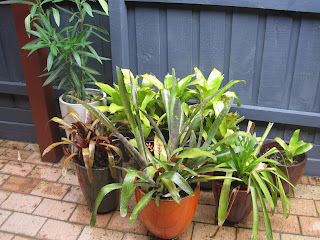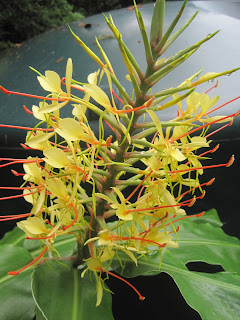 |
| About a third of the Bromeliad collection with a few 'ring-ins' |
On speaking to a member of the Society at a plant show he informed me that bromeliads are hardier than they look and are very adaptive to home environments, that is if you persevere in your preferred position for about 3 years and the plant hasn't died in the meantime! Bromeliads come in many varieties and in nature have adapted to environments as diverse as rainforests and deserts, as well as adapting to altitudes ranging from sea level to over 4,000 meters. The majority of them are native to the tropical Americas however a few of them may be found in the American subtropics with one group found in tropical West Africa.
The temptation is to keep these plants moist but some of them have the tendency to develop a white, powdery mildew around the base if overly wet (and can rot at the base). As the aspect of the majority of bromeliads at 'Wheelers' are subject to the unpredictable Melbourne weather it is difficult to control their exposure to the elements, and the pots are too heavy to move too often. However, as yet I haven't lost any plants and several of them have had new plants emerging (pups) which is very exciting.
My plan in later blogs is to highlight some of the individual bromeliads. I have recently 'planted' the tops of a couple of store bought pineapples (also members of the Bromeliad family) and am hopeful that in about 3-4 years that they may fruit; nothing ventured, nothing gained!
G.




































